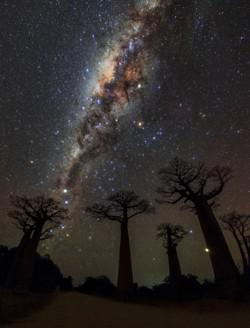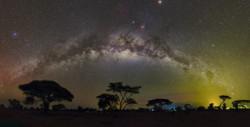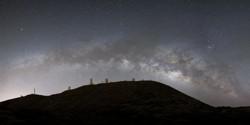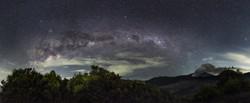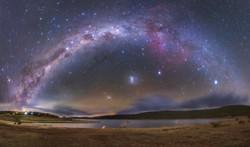Glossary term: L'extinction interstellaire
Description: L'extinction interstellaire est l'effet combiné de l'absorption et de la diffusion de la lumière provenant de sources astronomiques par la matière interstellaire. La matière interstellaire est la matière présente dans l'espace entre les étoiles des galaxies et se compose de gaz et de particules de poussière de taille submicronique. La poussière interstellaire a un effet beaucoup plus important sur la lumière des étoiles que les particules de gaz. D'immenses trainées de poussière et de gaz dans la Voie lactée peuvent être observées à l'œil nu comme des espaces entre les faibles lueurs de millions d'étoiles. L'extinction rend difficile l'observation des régions où il y a beaucoup de gaz et de poussière. L'extinction est généralement plus importante à des longueurs d'onde plus courtes, ce qui fait apparaître les objets astronomiques plus rouges (rougissement). Cette variation due à la longueur d'onde signifie que les astronomes utilisent souvent des longueurs d'onde plus grandes, comme la lumière infrarouge ou submillimétrique, pour étudier les régions couvertes de poussière, telles que les régions de formation d'étoiles.
Related Terms:
- Extinction atmosphérique
- Dust
- Extinction
- Gaz
- Infrared Astronomy
- Voie lactée
- Star Formation
- Submillimeter Astronomy
See this term in other languages
Term and definition status: The original definition of this term in English have been approved by a research astronomer and a teacher The translation of this term and its definition is still awaiting approval
The OAE Multilingual Glossary is a project of the IAU Office of Astronomy for Education (OAE) in collaboration with the IAU Office of Astronomy Outreach (OAO). The terms and definitions were chosen, written and reviewed by a collective effort from the OAE, the OAE Centers and Nodes, the OAE National Astronomy Education Coordinators (NAECs) and other volunteers. You can find a full list of credits here. All glossary terms and their definitions are released under a Creative Commons CC BY-4.0 license and should be credited to "IAU OAE".
Related Media
Conduire
Credit: Marcin Zajac/IAU OAE
License: CC-BY-4.0 Creative Commons Attribution 4.0 International (CC BY 4.0) icons
Voie lactée au-dessus de l'Avenue des Baobabs
Credit: Amirreza Kamkar/UAI OAE
License: CC-BY-4.0 Creative Commons Attribution 4.0 International (CC BY 4.0) icons
Voie lactée sur le parc national d'Amboseli
Credit: Amirreza Kamkar/UAI OAE
License: CC-BY-4.0 Creative Commons Attribution 4.0 International (CC BY 4.0) icons
Teide Observatory
Credit: Curd-Christian Tengeler/IAU OAE
License: CC-BY-4.0 Creative Commons Attribution 4.0 International (CC BY 4.0) icons
Oregon Coast
Credit: Marcin Zajac/IAU OAE
License: CC-BY-4.0 Creative Commons Attribution 4.0 International (CC BY 4.0) icons
Equatorial Milky Way
Credit: Giorgia Hofer/IAU OAE
License: CC-BY-4.0 Creative Commons Attribution 4.0 International (CC BY 4.0) icons
Milky Way Arch over La Palma
Credit: Amirreza Kamkar/IAU OAE
License: CC-BY-4.0 Creative Commons Attribution 4.0 International (CC BY 4.0) icons
The Moon and Milky Way arch Above the Golden Hall
Credit: Likai Lin/IAU OAE
License: CC-BY-4.0 Creative Commons Attribution 4.0 International (CC BY 4.0) icons
La voie lactée au-dessus de Anglers Reach
Credit: Lucy Yunxi Hu/IAU OAU
License: CC-BY-4.0 Creative Commons Attribution 4.0 International (CC BY 4.0) icons
The Pillar of Creation
Credit: Giorgia Hofer/IAU OAE
License: CC-BY-4.0 Creative Commons Attribution 4.0 International (CC BY 4.0) icons

